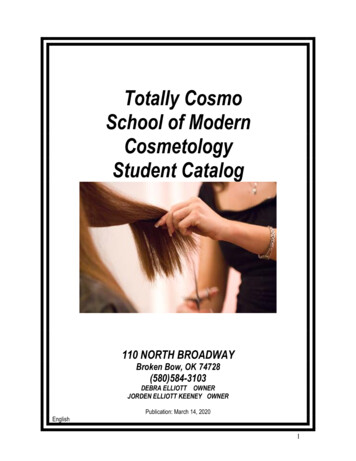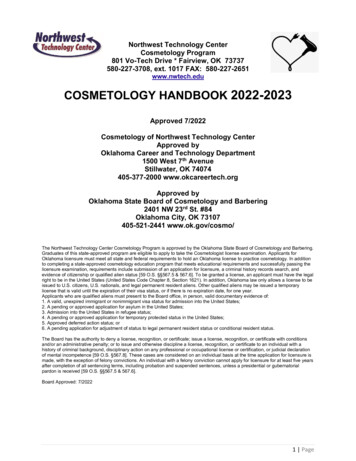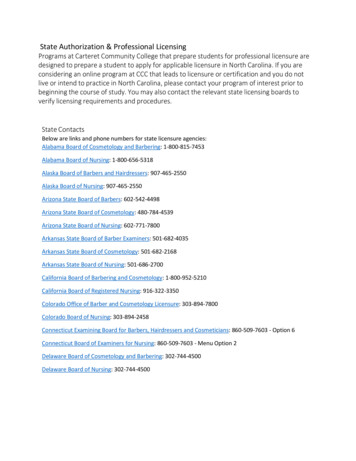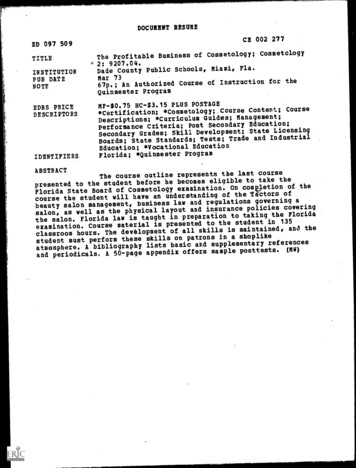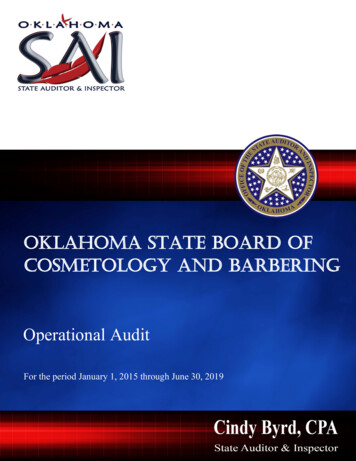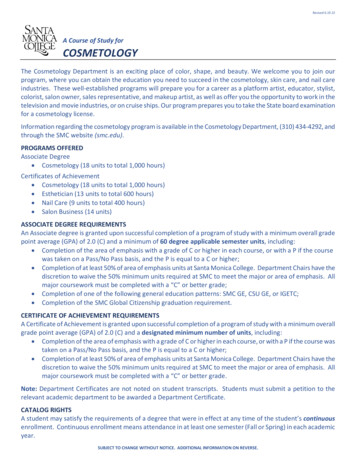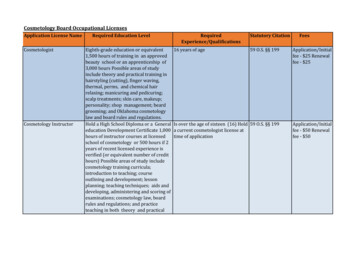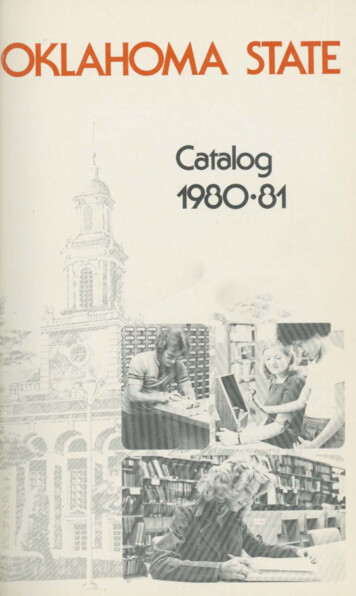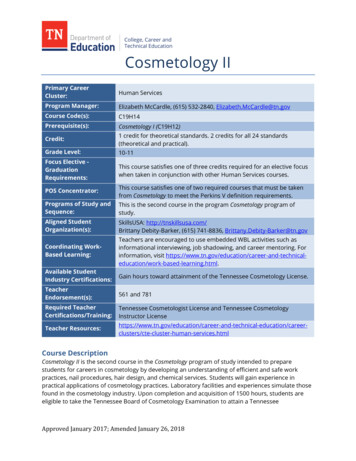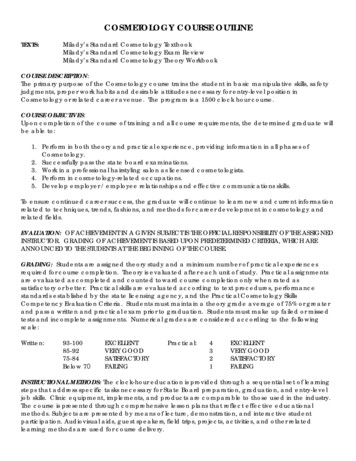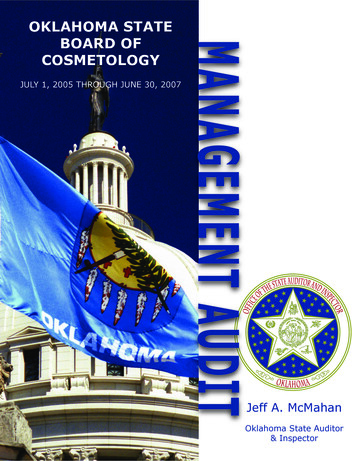
Transcription
JULY 1, 2005 THROUGH JUNE 30, 2007MANAGEMENT AUDITOKLAHOMA STATEBOARD OFCOSMETOLOGYJeff A. McMahanOklahoma State Auditor& Inspector
Audit Report of theOklahoma StateBoard of CosmetologyFor the PeriodJuly 1, 2005 through June 30, 2007This publication is printed and issued by the State Auditor and Inspector, as required by 74 O.S. §212. Pursuant to 74 O.S.,§3105, 18 copies have been prepared and distributed at a cost of 27.41. Copies have been deposited with the PublicationsClearinghouse of the Oklahoma Department of Libraries.
January 14, 2008TO THE EXECUTIVE DIRECTOR OF THE OKLAHOMASTATE BOARD OF COSMETOLOGYPursuant to 62 O.S. § 212, transmitted herewith is the audit report for the Oklahoma State Board of Cosmetology forthe period July 1, 2005 through June 30, 2007. The Office of the State Auditor and Inspector is committed to servingthe public interest by providing independent oversight and by issuing reports that serve as a management tool to theState. Our goal is to ensure a government that is accountable to the people of the State of Oklahoma.We wish to take this opportunity to express our appreciation to the agency’s staff for the assistance and cooperationextended to our office during the course of our engagement.Sincerely,JEFF A. McMAHANState Auditor and Inspector
Mission StatementThe mission of the Oklahoma State Board of Cosmetology is to safeguard and protect the health and general welfare ofthe people of the state of Oklahoma by performing a variety of services from developing curriculum for cosmetologyschools to administering examinations for prospective practitioners of the cosmetology arts.Board MembersGretchen Payne.ChairFreda Poe.Vice ChairLoyd Saxton. MemberLaFaye Austin. MemberKen Young. MemberCarol DeWitt. MemberJerry Kelon Carter II. MemberTuan Nguyen. MemberJanet Dale Webb. MemberKey StaffBetty Moore. Executive DirectorCandis Ross. Administrative Assistant to the DirectorJennifer McCree.Principal Assistant2
TO THE EXECUTIVE DIRECTOR OF THE OKLAHOMASTATE BOARD OF COSMETOLOGYWe have audited the Oklahoma State Board of Cosmetology (Board) for the period July 1, 2005 through June 30, 2007. Theobjectives of this audit were to determine if: The Board’s internal controls provide reasonable assurance that revenues and expenditures were accuratelyreported in the accounting records, and financial operations complied with applicable finance-related laws andregulations;The Board complied with 74 O.S. § 3601.2, 62 O.S. § 211 and the Department of Central Services’ PurchaseCard Procedures;Recommendations included in prior engagements were implemented.As part of our audit we obtained an understanding of internal controls significant to the audit objectives and consideredwhether the specific controls have been properly designed and placed in operation. We also performed tests of certaincontrols to obtain evidence regarding the effectiveness of the design and operation of the controls. However, providing anopinion on internal controls was not an objective of our audit and accordingly, we do not express such an opinion.We also obtained an understanding of the laws and regulations significant to the audit objectives and assessed the risk thatillegal acts, including fraud, violation of contracts, grant agreements, or other legal provisions could occur. Based on thisrisk assessment, we designed and performed procedures to provide reasonable assurance of detecting significant instancesof noncompliance with the laws and regulations. However, providing an opinion on compliance with these laws andregulations was not an objective of our audit and accordingly, we do not express such an opinion.Our audit was conducted in accordance with applicable standards contained in Government Auditing Standards, issued bythe Comptroller General of the United States, and included such procedures as we considered necessary in the circumstances.This report is a public document pursuant to the Oklahoma Open Records Act (51 O.S. § 24A.1 et seq.), and shall be open toany person for inspection and copying.JEFF A. McMAHANState Auditor and InspectorJanuary 11, 20083
BackgroundThe Oklahoma State Board of Cosmetology (Board) licenses and regulates the profession of cosmetology, esthetics,manicuring, instructors and establishments where these services are performed as well as regulates health and safetyissues in schools approved by the Board. The Board’s operations are governed by 59 O.S. § 199.1 through 199.15 aswell as Title 175 of the Oklahoma Administrative Code. Oversight is provided by a nine-member board comprised ofa member from each congressional district with the additional members appointed at large. Six members shall, at thetime of appointment, have had at least five years continuous practical experience in the practice of cosmetology in thisstate, one member shall be a lay person, one member shall be an administrator of a licensed private cosmetology school,and one member shall be an administrator of a public school licensed to teach cosmetology. The Board pays for itsoperations through the various fees they charge. The fees include, but are not limited to, multiple types of licenses aswell as examinations.Table 1 summarizes the Board’s sources and uses of funds for fiscal years 2006 and 2007.Table 1-Sources and Uses of Funds for FY 2006 and FY 2007Sources:2006Cosmetology License Fee 706,696Uses:Personnel ServicesProfessional ServicesTravelMisc. AdministrativeGeneral OperatingOffice Furniture and EquipmentOtherTotal Uses2007 840,738 582,08821,88286,32962,95655,4678,51545,057 648,29720,90566,21036,56843,7735,87131,473 862,294 853,097Source: Oklahoma CORE Accounting System.Through conversations with Board management in early 2007, the State Auditor’s Office (SA&I) learned the Boardbelieved they were in a financial crisis. They were not aware of what had caused the situation but knew their actual cashwas much less than they originally believed.By November 2007, management believed the situation had been corrected by working with the Office of State Finance(OSF). OSF determined management had mistakenly reported transfers from the clearing account to their revolvingfund as “vouchers” on eleven OSF-Form 11 clearing account reconciliations dating back to December 2003. Therefore,OSF was classifying the transfers as expenditures in preparing the Board’s “Summary of Receipts and Disbursements”report in the CORE accounting system. These errors grossly misstated the Board’s clearing account cash balance on thisreport. OSF made a 768,017 adjustment in February 2007 to correct the invalid expenditures which had been reported.We reviewed each of the reconciliations in question and determined the amount presented as “vouchers” was identifiedas transfers on the prior month’s “fax request for transfer of funds” sent to the State Treasurer. The total of the elevenmonths’ transfer amount was 768,017.There appears to have been confusion on management’s part as to how to obtain an accurate, available cash balancefrom the CORE system during this period. Therefore, they relied solely on their former OSF budget analyst for thisinformation. Management stated the analyst consistently informed them they had sufficient cash. Therefore, they werespending much more than they were bringing in based on the presumption of a large cash balance. Table 2 presents theBoard’s deposits and expenditures for each month of the period.4
Table 2 – Deposits and Expenditures by Month – FY 2006 and 2007MonthDepositsExpenditures - Fund200ApproximatePersonnel 5,53854,00038,236SOURCE: Oklahoma CORE Accounting System -- Amount presented for personnel services is anestimate based on information from OSF’s combining trial balance report.Based on this trend, the Board had 4,435 in their fund 200 as of June 30, 2007.Through conversation withmanagement and review of other OSF-Form 11 reconciliations, it appears management is now clear on how to completethe reconciliation.Recommendation: The OSF-Form 11 reconciliations we inspected were approved by an employee independent of thepreparer; however, we recommend this review include agreeing all amounts reported back to source documentation.Views of Responsible Officials: Because the agency is so small in personnel numbers, the practice has not been to havesomeone, other than the preparer, perform a detailed review of each OSF Form 11 reconciliation, since the Director hadbeen reviewing these documents and approving by signing them monthly after the Assistant to the Director preparesthem. This had been the agency’s past practice and other auditing teams have approved this process. The agencyagrees to comply with the recommendation while allowing the Assistant to the Director to prepare the OSF Form 11reconciliation (because she has more immediate access to the information to prepare the document) and, in the absenceof an Executive Director at this time, the Principal Assistant will conduct a detailed review including ensuring thatall amounts report back to source documentation. This process will be in place immediately until a new Director isappointed by the Board and a policy and procedure can be in place in the agency’s policy and procedures manual withkey personnel named in the process. The agency believes this will strengthen the Board’s internal control process relatedto receipts, expenditures and capital assets.5
Objective 1 – Determine if the Board’s internal controls provide reasonable assurance that revenues and expenditureswere accurately reported in the accounting records, and financial operations complied with applicable finance-relatedlaws and regulations.ConclusionBased on the procedures performed, the Board’s internal controls related to receipts, expenditures, and capital assets aregenerally effective; however, several areas, as noted below, need to be strengthened.MethodologyTo accomplish our objective, we performed the following: Reviewed 62 O.S. § 7.1;Documented internal controls related to the receipting, expenditure, and capital assets process;Tested controls which included:o Determining if checks are endorsed upon receipt;o Reviewing 40 deposits from the period to ensure the deposit slip was initialed by the reviewer and wassupported with the appropriate receipt log;o Determining if receipts are stored in a secure location prior to deposit;o Reviewing 40 deposits from the period to ensure the bank deposit date was within one day of the depositslip date;o Reviewing 40 deposits to ensure the deposit was posted into CORE within one day of being deposited atthe bank;o Reviewing a CORE deposit report for the period to ensure funds are being transferred from the Board’sclearing account to the revolving fund at least once per month;o Reviewing six transfer fax forms from the period to ensure they were reviewed;o Reviewing six OSF-Form 11 reconciliations to ensure the preparer and reviewer are independent of eachother and the reconciling items are adequately supported.o Reviewing 41 expenditure claims to ensure they were properly authorized. This included ensuring theinvoice supported the payment, the invoice was mathematically accurate, and the correct account codewas used;o Determining if the employee responsible for receiving warrants from OSF is independent of the postingand approval process;o Determining if an inventory listing is maintained and contains the items’ inventory tag number, description,cost, serial number (if applicable), and date sent to surplus (if applicable);o Reviewing 15 assets from the inventory listing to verify their existence on the floor, ensuring they areidentified as property of the State, and ensuring the inventory tag number and serial number agree to thelisting;o Reviewing 10 assets from the floor to verify they are identified on the inventory listing, ensuring they areidentified as property of the State, and ensuring the inventory tag number and serial number agrees to thelisting;o Determining all items surplused during the period had an approved DCS Form 001 supporting theirremoval.ObservationsSecuring Funds Prior to DepositAn effective internal control system provides for adequate safeguarding of assets. Based on conversation withmanagement, funds are maintained in a safe in the Administrative Assistant to the Director’s office prior to deposit.However, the safe is kept unlocked during business hours while Board personnel access the safe for items throughoutthe day. Improprieties could occur and not be detected in a timely manner.Recommendation: We recommend either the safe be locked when funds awaiting deposit are placed inside or the fundsbe maintained in a locking file cabinet. In both cases, access should be limited to essential personnel only.6
View of Responsible Officials: The agency has no problem securing the deposit by locking the safe so the awaitingdeposit can be secured inside so that only limited, essential personnel only have access to the safe and contents duringthis time of day. Most generally, the deposit may sit in the safe for 15 minutes on an average mail/deposit day. Theagency agrees this will avoid improprieties that could occur and not be detected in a timely manner.Reconciliation to CORE RecordsAn effective internal control system provides for adequate reconciliation of accounting records. Based on observation ofan OSF-Form 11 reconciliation for each month of the period, management reconciles their clearing account to the StateTreasurer’s Office. However, they do not formally reconcile their clearing account or revolving fund to CORE records.Without an official reconciliation to CORE, transactions that were inadvertently not posted or posted incorrectly may goundetected.Recommendation: We recommend management develop a formal process for reconciling their clearing accountand revolving fund to CORE on a monthly basis. This should include a detailed review by someone other than thepreparer.View of Responsible Officials: Because the agency is so small in personnel numbers, the practice has not been to havesomeone, other than the preparer, perform a detailed review for reconciling the clearing account and revolving fund toCORE on a monthly basis. This has been the agency’s past practice, since the review of these prepared documents weredone and informally approved by the Director after the Assistant to the Director prepares them. Additionally, the Boardvotes on and approves these reports quarterly. The agency agrees to comply with the recommendation while allowingthe Assistant to the Director to prepare the reconciliation (because she has more immediate access to the informationto prepare the document), with the Principal Assistant, in the absence of an Executive Director, performing a detailedreview of the reconciliation for the clearing account to the revolving fund to CORE on a monthly basis. This processwill be in place immediately until a new Director is appointed by the Board and a policy and procedure can be placedin the agency’s policy and procedures manual with key personnel named in the process. The agency believes thisformalized process with an official reconciliation to CORE and the clearing account or revolving fund, transactions thatwere inadvertently not posted or posted incorrectly will not go undetected. The agency further believes that postingdeposits into CORE within one day of receipt (as has been the practice since June 2007 already and as listed in therecommendation to follow) will assist in the process to officially reconcile to CORE. It is also important to note thatthe agency can never balance to the CORE reports because the agency makes at least two deposits daily and the agencyalways has deposits in transit.Posting Deposits to CORE in a Timely MannerAn effective internal control system provides for prompt recording of accounting transactions. Based on proceduresperformed, 37 of 40 deposits were not posted into CORE within one day of deposit. The average span between the bankdeposit date and the CORE journal date was 6 days. In the CORE system, the cash is not available until the journalentry is made and added to the agency’s cash balance. Therefore, the available cash balance on CORE reports could bemisstated. Management indicates this issue was brought to their attention by OSF in June 2007 and has been makingmore timely entries since that time.Recommendation: We recommend management exercise diligence and ensure their deposit entries are posted intoCORE within one day of receipt.View of Responsible Officials: The Assistant to the Director has been posting deposit entries into CORE within oneday of receipt since June 2007 as recommended in this report in an effort to resolve any posting problems into CORE.The agency agrees to continue to complying with practice and recommendation. The Principle Assistant has registeredfor a Journal Entry Class to attend on January 30, 2008 so she can perform this duty in the absence of the Assistant tothe Director.Review of Expenditure Claims Prior to Approval62 O.S. § 7.1 E. states in part, “At least once each month each state agency shall transfer monies deposited in agencyclearing accounts to the various funds or accounts, subdivisions of the state, or functions as may be provided by7
statute and no money shall ever be disbursed from the agency clearing account for any other purpose, except in refund oferroneous or excessive collections and credits ”An effective internal control system provides an adequate review of supporting documentation.During procedures performed, we noted one claim was paid from the clearing account for reimbursement of travelcosts. On a separate claim, management did not appear to review the invoice in detail prior to authorizing payment. Theamount requested and the supporting detail differed by 900. There was no indication on the invoice that managementinquired as to the difference.Recommendation: We recommend management exercise diligence in reviewing expenditure claims to ensure thecorrect fund and account code are used as well as ensuring the invoice is mathematically correct.View of Responsible Officials: The agency recognizes that there has been a problem in the past with ensuring thecorrect fund and account code is used as well as ensuring the invoice is mathematically correct. Agency managementhas been working diligently to ensure these types of errors do not occur in the future. The agency agrees to adopt theirown formalized process during the interim period when a new Director is appointed by the Board, to have the PrincipleAssistant perform a review, including review of the supporting documentation, to ensure the correct fund, account codeand the invoice is mathematically correct prior to submission to OSF. When a new Director is hired, the agency agreesto develop a policy and procedure for the manual to formalize the checking and review process.Incomplete Data on Inventory ListingOklahoma Administrative Code (OAC) 580:70-3-1 states in part (c) Inventory report contents. The inventory report shall be signed by the agencyinventory control officer and shall include for each tangible asset:(1) the agency number;(2) the asset tag number;(3) the model and serial number, if any;(4) the manufacturer;(5) the description;(6) product name;(7) physical location;(8) acquisition date and cost; Based on procedures performed, four out of 15 items did not have the serial numbers recorded on the inventory listing.Without all required identification information being maintained, it may be difficult to determine the identity of aparticular asset.Recommendation: If an asset has a specific identification number, we recommend management ensure it is properlyrecorded on their inventory listing.View of Responsible Officials: Agency staff, the Administrative Technician, is responsible for maintaining the inventorylistings and performing the statutorily required inventory. The agency agrees to comply with the recommendationimmediately and list the serial number on equipment when applicable.Inadequate Supporting DocumentationAn effective internal control system provides for adequate supporting documentation. Based on review of the Board’sinventory report, a computer monitor was identified as being surplused on May 31, 2006. However, based on discussionwith management, the monitor was not surplused but replaced by their computer support vendor because it was no longerin working condition. However, the vendor did not provide management with any supporting documentation when thereplacement occurred. We requested management call the vendor for support and they were provided a service reportwhich indicated the vendor went to the Board’s office on the morning of May 31, 2006 and replaced a Compaq monitor.However, there is no indication on the service report of the serial number or tag number of the monitor that was removedfrom the Board’s possession or serial number of the new monitor. Additionally, the inventory listing does not identify8
the serial number of the item which was replaced. Therefore, even if the service report identified the serial number of themonitor which was replaced, we could not determine if it was the monitor on the inventory listing.Recommendation: As equipment is retired from service through the normal surplus process or due to malfunction,appropriate documentation should be maintained.View of Responsible Officials: As stated previously, the agency agrees that the serial number would be helpful whenperforming the statutorily required inventory in cases where the computer support vendor has replaced a piece ofequipment and tracking the equipment for surplus. The agency will communicate the requirement that the computersupport vendor supply the agency with the serial number of the “replaced” piece of equipment so that the inventorylisting can promptly be updated as required to more easily determine the identity of a particular asset.Objective 2 – Determine if the Board complied with 74 O.S. § 3601.2, 62 O.S. § 211 and the Department of CentralServices’ (DCS) Purchase Card Procedures.ConclusionBased on procedures performed, it appears the Board is in compliance with 74 O.S. § 3601.2 and adequately addressedconcerns previously noted in the DCS Audit Unit’s purchase card review. However, the Board is not in compliance with62 O.S. § 211 and should transfer 5,727.25 to the State’s general fund.MethodologyTo accomplish our objective, we performed the following: Reviewed 74 O.S. § 3601.2 and performed procedures to determine if the executive director’s salary was incompliance with the law;Reviewed 62 O.S. § 211 and performed procedures to ensure the Board transferred 10% of the fees charged,collected, and received to the State’s general fund ;Reviewed DCS’ Purchase Card Procedures;Reviewed DCS Audit Unit’s purchase card review on the Board for fiscal year 2005 and performed proceduresto determine if the Board corrected the issues identified in that report.Observations62 O.S. § 211 states, “Unless otherwise provided by law, all self-sustaining boards created by statute to regulate andprescribe standards, practices, and procedures in any profession, occupation or vocation, shall pay into the GeneralRevenue Fund of the State ten percent (10%) of the gross fees charged, collected and received by such board.” Duringprocedures performed to ensure the Board transferred 10% of all fees received to the State’s general fund, we noted thefollowing:oBased on review of transfers made throughout the period, the Board typically made transfers to the statemonthly. The State Treasurer’s (OST) monthly statement for October 2005 indicated 63,105.50 was depositedin the Board’s clearing account. Board documentation indicates a form was faxed to the OST on November3, 2005 instructing them to transfer 6,310 (10% of total amount deposited) from the clearing account to theState’s general fund. According to CORE records and conversation with OST management, this transfer neveroccurred. OST management stated their records indicate a transfer request for this amount was not received viafax. Board management did not notice this transfer was not identified on the subsequent month’s OST statement.Additionally, during the other months of the period, it appears Board management transferred 582.25 morethan required to the State’s general fund.9
Recommendation: We recommend the following:oThe Board should no longer request OST make their transfers to the State’s general fund and their revolvingfund. The transfers should be made by Board personnel;oThe Board should transfer 5,727.75 ( 6,310 - 582.25) to the State’s general fund to represent the differencebetween 10% of fees deposited in October 2005 and the excess amount paid throughout the remaining period.Views of Responsible Officials: The agency recognizes that there has been a problem in the past with ensuring transfersfrom the clearing account to the state general fund was performed correctly. The agency has implemented formal checkprocesses as previously stated in other responses that ensure transfers are correct prior to submission. The agencyfurther recognizes that corrections have not been made as requested to OST in a timely manner. The Board’s BudgetCommittee gave approval to the Assistant to the Director to perform the transfers, rather than requesting OST do thisbecause of past problems. Please note: This recommendation is confusing because past Auditor teams have suggestedthat the Assistant to the Director not have the authority to do the transfer.Auditor’s Response: Based on review of the previous report issued by the State Auditor’s Office on April 19, 2006,there were no recommendations related to Board personnel not having the authority to perform the transfers.Objective 3 – Determine if recommendations from prior engagements were implemented.ConclusionBased on review of the prior engagement report issued by the State Auditor’s Office on April 19, 2006, there were nofindings reported. Therefore, procedures related to this objective were not performed.Other Items NotedThe State of Oklahoma’s Information Security Policy, Information and Guidelines states in part: “ The confidentialityof all information created or hosted by a State Agency is the responsibility of that State Agency The objective of theowning State Agency is to protect the information from inadvertent or intentional damage, unauthorized disclosure oruse ” This policy includes “any data or knowledge collected, processed, stored, managed, transferred or disseminatedby any method.” Based on conversation with management, sensitive data is maintained in hard copy format within theBoard’s office and may not be adequately secured after business hours. We found no evidence to suggest sensitive datahad been compromised, but the lack of safeguarding the information makes it a risk.Recommendation: We recommend management explore options for adequately securing sensitive data after businesshours.Views of Responsible Officials: Sensitive data has always been in physical files of licensees and placed on shelvesin the office of the Board. Past Auditor teams have not found this to be a problem. To secure these records, the Boardwould have to budget and build a locking wall system to secure these files. This could pose a problem with the presentbudget situation; however, it might be something to consider when funds become available. Everyone in the officeneeds access to the files during working hours. It would be a great inco
The Oklahoma State Board of Cosmetology (Board) licenses and regulates the profession of cosmetology, esthetics, manicuring, instructors and establishments where these services are performed as well as regulates health and safety issues in schools approved by the Board. The Board's operations are governed by 59 O.S. § 199.1 through 199.15 as
